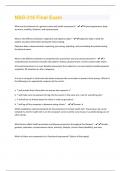NSG -316 Final Exam
What are the elements of a general survey and health assessment? - ✔✔Physical appearance, body
structure, mobility, behavior, and measurement
What is the difference between subjective and objective data? - ✔✔ Subjective data is what the
patient say about themselves during the history taking.
Objective data is observed whe n inspecting, percussing, palpating, and auscultating the patient during
the physical exam.
What is the difference between a comprehensive assessment and a focused assessment? - ✔✔ A
comprehensive assessment includes the patient's history, physical exam, a nd VS; yearly health exams.
A focused assessment is a more detailed assessment that related to a current medical condition/patient
complaint; ER situations or after a diagnosis
A nurse is caring for a client who asks about measures the nurse takes to prot ect client privacy. Which of
the following is an appropriate response by the nurse?
a. "I will provide their information to anyone who requests it."
b. "I will make sure my password to log into the system is the same one I use for everything else."
c. "I will talk to my friends about the client in order to get advice."
d. "I will log off the computer in between seeing clients." - ✔✔ Answer: d
HIPAA establishes national standards for the protection of certain health info. The privacy rule can be
violated if a client's health info is on the computer screen and the nurse leaves it up while taking care of
other clients.
What factors affect health promotion and disease prevention throughout the lifespan? - ✔✔ Gender,
genetics, education, socioeconomic status, eth nicity, lifestyle, chronic illness/disability, and race
Which of these are components of a functional assessment? (Select all that apply)
1 / 3
a. vision and hearing
b. mobility
c. continence
d. nutrition
e. ADL -IADL - ✔✔ Answer: all of them :)
A functional ass essment also includes mental status, affect, home environment, and social support!
What is the key to understanding cultural diversity? - ✔✔ Being self -aware and having knowledge of
one's own culture
FICA is an assessment tool used to determine a patient's spiritual history. What does FICA stand for? -
✔✔ F = faith
I = importance/influence
C = community
A = address/action
What components should be assessed and asked about when completing a cultural ass essment? -
✔✔ Heritage, health practices, communication, family roles & social orientation, nutrition, pregnancy,
spirituality/religion, death, and role of health providers
What are the four sources of pain? (Provide some examples for each) - ✔✔ 1. Visceral pain = large
interior organs (e.g., appendicitis, gallstones)
2. Deep somatic pain = blood vessels, joints, tendons, muscles, and bone injury (e.g., sprain, broken
bone)
3. Cutaneous pain = skin surface and subcutaneous tissues (e.g., paper cut)
4. Referr ed pain = felt at a particular site but originates from another location (e.g., left arm hurting
during an MI although the issue is with the heart)
A patient is crying and says, "Please get me something to relieve this pain." What should the nurse do
next ?
2 / 3
a. Verify that the patient has an order for pain medications and administer order as directed
b. Assess the level of pain and ask patient what usually works for his or her pain, administer pain
medication as needed, then reassess pain level
c. Assess th e level of pain and give medications according to pain level, and then reassess pain
d. Reposition the patient, then reassess the pain after intervention - ✔✔ Answer: B
Answers A, C, and D are incorrect because pain management should be collaborative, and the patient is
not part of the decision making process in these answers.
Pain is always ____? - ✔✔ Subjective!
A patient with a severe muscle cramp tells the nurse, "The pain is a little better when I massage the
muscle or apply a cold pack." Which criter ion of the PQRST method of pain assessment is addressed in
the patient's statement?
a. Severity Scale
b. Quality/Quantity
c. Region/Radiation
d. Provocation/Palliation - ✔✔ Answer: d
PQRST is a pain assessment scale; it stands for Provocation/Palliation, Quality/Quantity,
Region/Radiation, Severity Scale, and Timing. Because the patient is describing methods that provide
comfort and relieve the pain, it indicates that the patient is ad dressing Provocation/Palliation. If the
patient reports about severity of pain on a scale of 0 to 10, then it indicates that the patient is
addressing Severity. When addressing the Quality/Quantity of the pain, the patient describes the pain
felt. If the p atient reports about the site of pain, then the patient is addressing Region/Radiation.
Stages of Edema - ✔✔ 1+ mild, slight indentation, no perceptible swelling
2+ moderate, indentation subsides rapidly (seconds)
3+ deep, indentation remains for short tim e (minutes), appears swollen
4+ very deep, indentation lasts long time (hours), appears very swollen
Powered by TCPDF (www.tcpdf.org)
3 / 3




